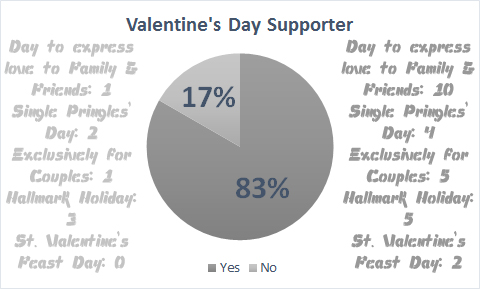Valentine’s Day: Not just a ‘Hallmark Holiday’

February 14th: the Hallmark Holiday? Or rather, is it a saint’s feast day? Or, is it just a day set aside to express our love for others? Whatever the day stands for, it has been called Valentine’s Day since the fifth century.
As the feast day of St. Valentine, the day’s history is murky. The most prominent complication is that the Catholic Church recognizes three Saint Valentines. According to one legend, Valentine was a Roman priest during the third century. The emperor at the time, Claudius II, decreed that no young men could be married because he wanted them to become soldiers. Valentine defied him and continued performing ceremonies for young lovebirds, leading to Claudius ordering his death. This legend possibly contributed to love being celebrated on Valentine’s Day. Another legend says Valentine was killed while attempting to smuggle Christians out of torturous Roman jails. At a time when Valentine himself was incarcerated, he is said to have written a letter to a girl who visited him and signed it “From your Valentine,” a phrase still alive today.
The origin behind the date of Valentine’s Day is also unclear. Some celebrate it as the anniversary of St. Valentine’s death. Others say that the Christian church decided to celebrate the saint at this specific time in an attempt to make Lupercalia, a festival dedicated to the Roman god of agriculture, part of the church’s traditions. However, since the Roman traditions required pagan sacrifices, the festival was outlawed at the beginning of the fifth century. Around the same time, Pope Gelasius established Feb. 14 as St. Valentine’s Day.
Even so, it was still a while before the day became associated with love. During the Middle Ages, those in France and England believed the day to begin birds’ mating season. The oldest Valentine in existence today is a poem. Written in 1415, Duke Charles of Orleans sent it to his wife from his prison in the Tower of London during the Battle of Agincourt.
Valentine’s Day is celebrated in the United States, Canada, Mexico, the United Kingdom, France and Australia. In Great Britain, Valentine’s Day became popular during the 1600s. By the 1750s, friends and couples in all levels of society would exchange tokens of affection or handwritten notes. In 1900, improvements in the printing process led to printed cards replacing those transcribed notes. Having cards pre-made created a simpler way to express emotion during a time when bold expressions of love were very unpopular. The exchange of personal valentines caught on in the Americas around the early 1700s. Esther A. Howland was the woman behind the first valentines that were mass produced on American soil. She made them out of lace, ribbons and colorful pictures.
According to the Greeting Card Association, one billion cards are sent each year for the holiday, making Valentine’s Day the second largest card-sending holiday of the year, Christmas being the first. Women purchase 85 percent of these valentines, a whopping 850 million a year!
62 percent of all Americans celebrate Valentine’s Day. Popular practices include giving candy, flowers and cards and going to romantic dinners. Valentine’s Day practices are quite similar in Canada and Mexico. In the United Kingdom, most of the valentines are sent anonymously, even if they are to a spouse and, in addition to traditional gifts, electronic devices or accessories might be presented as well. 71 percent of the French celebrate Valentine’s Day, and the country lures many people to the City of Love: Paris. In Australia, Valentine’s Day is becoming more and more popular each year. Unlike in the United States, men buy more cards than women!
However, in recent years, Valentine’s Day has gained a reputation as a “Hallmark Holiday.” This is a phrase that describes a holiday that the card company Hallmark has supposedly taken over and commercialized solely for their benefit and profit. According to Hallmark, “while we’re honored that people so closely link the Hallmark name with celebrations and special occasions, we can’t take credit for creating holidays… like Valentine’s Day.” Even so, people have become critical of Valentine’s Day and its commercial traits.
“They rack up chocolate prices for no reason. I want a box of chocolate and I don’t want it heart shaped,” Sophomore Ava Colorito said.
While some people don’t like Valentine’s Day for it’s commercialism, others wish it was more inclusive. One of strongest stereotypes of Valentine’s Day, besides the commercialism, is that it is only for couples. This thought is slowly coming to include family and friends.
“Valentine’s Day, to me, is a chance to show other people, whether a significant other, best friend or a family member, that you really care about them,” Junior Brianna McKee said.
Whether or not you are in a relationship, support Valentine’s Day, or even like chocolate, Feb. 14 is a special day to take the time to tell your parents, siblings, relatives, pets, friends and anyone else in your life how much they mean to you.


